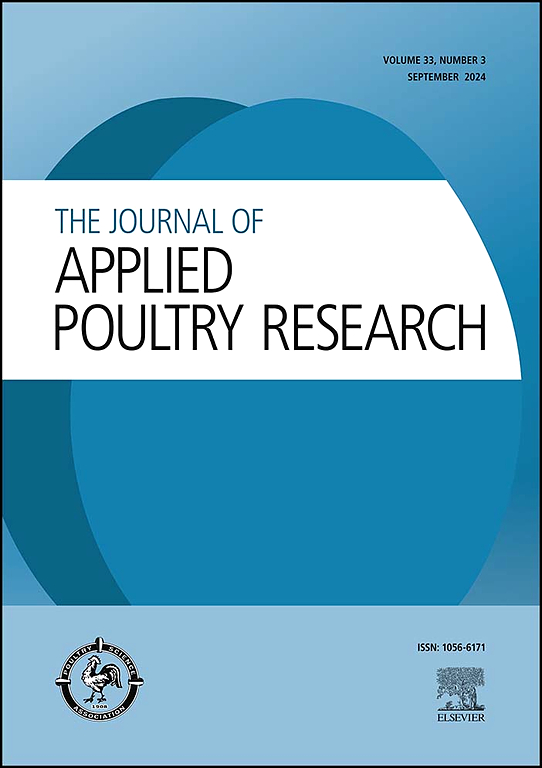饲粮中添加姜黄和姜粉对蛋鸡生产性能、血清化学和肠道微生物群的影响
IF 2
3区 农林科学
Q2 AGRICULTURE, DAIRY & ANIMAL SCIENCE
引用次数: 0
摘要
本试验旨在研究饲粮中添加姜黄和生姜对蛋鸡生产性能的影响。采用完全随机设计(CRD),选用160只商品高性白笼蛋鸡,随机分为4个饲粮处理,每个处理5个重复,每个重复8只鸡。T1组为对照组,仅饲喂基础饲粮,T2、T3和T4组分别在基础饲粮中添加1.0%姜黄+ 0.5%姜、0.5%姜黄+ 1.0%姜和0.75%姜黄+ 0.75%姜。试验期为45 ~ 54周龄,共10周。结果表明,与其他各组相比,T4组(0.75%姜黄+ 0.75%生姜)采食量降低,产蛋率提高,饲料系数提高(P < 0.0001)。所有添加组的鸡蛋均显著高于对照组(P < 0.0001)。血液学分析显示,T4组红细胞计数(P = 0.001)和血红蛋白水平(P = 0.037)升高,T2、T3和T4组白细胞计数升高(P = 0.003)。生化分析表明,在所有补充组中,血尿素氮显著降低(P = 0.001),总胆固醇显著降低仅在T4组中观察到(P = 0.001)。虽然T4组的大肠杆菌数量略高于T2和T3组(P = 0.001),但这并未对鸡的健康或生产性能产生负面影响。总的来说,T4饮食支持更高的生产力,有利的生理反应和改善的血脂谱。上述结果提示,在蛋鸡饲粮中添加0.75%的姜黄和生姜可能是提高蛋鸡生产性能和健康的有效策略。本文章由计算机程序翻译,如有差异,请以英文原文为准。
Impact of dietary turmeric and ginger powder on performance, serum chemistry and gut microbiota in laying hens
This study investigated the effects of dietary supplementation with turmeric and ginger on the performance of laying hens. A total of 160 commercial Hi-Sex White caged laying hens were randomly assigned to four dietary treatments, each consisting of five replicates of eight birds, using a completely randomized design (CRD). Group T1 served as the control and received only the basal diet, while groups T2, T3, and T4 were supplemented with 1.0 % turmeric + 0.5 % ginger, 0.5 % turmeric + 1.0 % ginger, and 0.75 % turmeric + 0.75 % ginger, respectively. The experiment lasted for 10 weeks, from 45 to 54 weeks of age. The results demonstrated that the T4 group (0.75 % turmeric + 0.75 % ginger) exhibited reduced feed intake, enhanced egg production, and an improved feed conversion ratio compared to the other groups (P < 0.0001). All supplemented groups produced significantly heavier eggs than the control (P < 0.0001). Hematological analysis revealed elevated red blood cell counts (P = 0.001) and hemoglobin levels (P = 0.037) in the T4 group, along with increased white blood cell counts in the T2, T3, and T4 groups (P = 0.003). Biochemical analysis indicated a significant reduction in blood urea nitrogen across all supplemented groups (P = 0.001), with a marked decrease in total cholesterol observed only in the T4 group (P = 0.001). Although the Escherichia coli count in the T4 group was slightly higher (P = 0.001) than in the T2 and T3 groups, this did not negatively affect the birds’ health or performance. Overall, the T4 diet supported superior productivity, favorable physiological responses, and an improved serum lipid profile. These findings suggest that a balanced dietary inclusion of turmeric and ginger at 0.75 % each may be an effective strategy to enhance the performance and health of laying hens.
求助全文
通过发布文献求助,成功后即可免费获取论文全文。
去求助
来源期刊

Journal of Applied Poultry Research
农林科学-奶制品与动物科学
CiteScore
4.10
自引率
10.50%
发文量
80
审稿时长
104 days
期刊介绍:
The Journal of Applied Poultry Research (JAPR) publishes original research reports, field reports, and reviews on breeding, hatching, health and disease, layer management, meat bird processing and products, meat bird management, microbiology, food safety, nutrition, environment, sanitation, welfare, and economics. As of January 2020, JAPR will become an Open Access journal with no subscription charges, meaning authors who publish here can make their research immediately, permanently, and freely accessible worldwide while retaining copyright to their work. Papers submitted for publication after October 1, 2019 will be published as Open Access papers.
The readers of JAPR are in education, extension, industry, and government, including research, teaching, administration, veterinary medicine, management, production, quality assurance, product development, and technical services. Nutritionists, breeder flock supervisors, production managers, microbiologists, laboratory personnel, food safety and sanitation managers, poultry processing managers, feed manufacturers, and egg producers use JAPR to keep up with current applied poultry research.
 求助内容:
求助内容: 应助结果提醒方式:
应助结果提醒方式:


